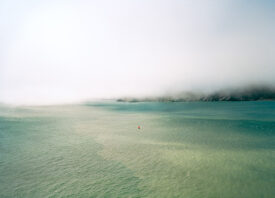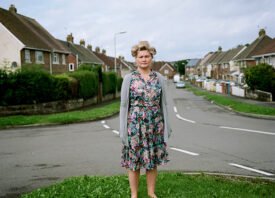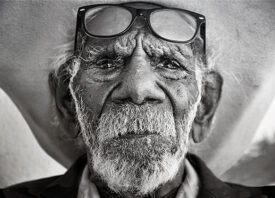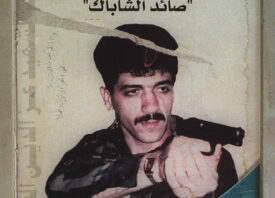Search this site
‘Take One a Day’ Exhibition Raises Suicide Awareness in Rural UK County

Trigger warning: Mention of suicide
Paul Gutherson, a Lincolnshire, UK resident, was out walking his dog one day when he found a suicide victim. Deeply traumatized by this event, he sought therapy and later started taking photos of his natural environment. One a day.
A chance discovery of these photos on Facebook by an old friend Jason Baron—former Head of Creative Photography at the BBC—led to the creation of the “Take One a Day” photo exhibition. Currently on view at Lincoln’s Usher Gallery (through September 15, 2024), the exhibition, curated by Baron, highlights a deeply personal and community-focused initiative around this sensitive topic, bringing the darkness into light, and bringing the local community together through art and discourse.
The photographs are all taken in Lincolnshire, a region with one of the highest suicide rates in the UK and one with significant mental health challenges, especially in its large farming community. The show features amateur photographer Paul Gutherson’s daily landscape photos alongside large-scale portraits of “mental health advocates and other people suffering from mental health challenges” by photographer Richard Ansett, as well as contributions from various local artists inspired by the project.
This project included engaging local groups like Men’s Shed and Bro Pro, who shared their stories and participated in the exhibition. This initiative aims not only to honor the memory of those lost but also to foster dialogue and support within the community.
We spoke with Baron to learn more about putting together this important show.
If you or someone you know is experiencing suicidal thoughts or a crisis, please reach out immediately for help. Here is a list of international suicide hotlines.

How did you become involved with this project?
‘Three years ago I kept seeing an old friend of mine, Paul Gutherson, posting a landscape photo a day on Facebook with no caption. I recognised the place as it was across the canal from my old house where I used to hang out with him when we were kids. We both grew up in a rural market town in the east midlands of England.
‘Paul is an amateur photographer and the pictures were just shot on iPhone but there
was an odd quality to them I found interesting. I contacted him and he told me the
story of how he came to ‘Take One a Day‘ in the place he did.
‘He was walking the dog one morning when he came across a bag on a bridge, looked around to see if anyone was there but no sign. Twenty minutes later he came back and found someone who’d died of suicide in the same place. Deeply traumatised he sought help and during therapy for PTSD he realised he needed to reclaim the positive feelings he
had about the place he loved walking the dog in and that had been part of his life for
decades. He decided to go there everyday and try and find something beautiful to
take a picture of.
‘Instead of ‘taking one a day’ of his prescribed Diazepam. It could be a flower, a sunrise, a big sky, his dog on the path etc. These are the pictures I saw and wanted to tell their story.
‘I’d curated a show for the BBC a year or so before and loved doing it. I knew this would be an interesting and potentially important project. And one which may in the end give meaning to the poor person who felt they couldn’t go on and who took their own life. In October 2023, I managed to get private funding to put on a show at Spout Yard Park, a small gallery in Louth, a town close to the landscapes, for World Mental Health Day 2023. Off the back of the success of that show we were offered two enormous rooms to fill with content at the prestigious Usher Gallery at Lincoln Museum (on view through September 15, 2024).’

How does this exhibition aim to contribute to conversations around suicide
prevention and mental health awareness?
‘Off the back of Paul’s photos, and the idea of a mental health awareness photography exhibition, photographic artist Richard Ansett, who I’d worked with on many assignments, kindly offered to explore the themes through portraiture. He’s a Samaritan volunteer and we’d done lots of mental health documentary shoots together for the BBC.
‘He took a trip to Lincolnshire and the place where Paul took the photos, contacting local Samaritan groups and others to get willing subjects. He came across two groups, Mens Shed and Bro Pro, and uncovered stories of people with their own mental health difficulties who were willing to tell them and have their photos taken. We found brilliant stories and lovely people, from mental health practitioners and Samaritan volunteers, to people really struggling mentally.
‘Off the back of visiting the space many people have been moved to reach out to friends and relations and the groups involved to seek help.’

What is it about this particular land/area made it the right fit for exploring the
topic of suicide?
‘Lincolnshire has a large farming community with issues of rural isolation, and suicide
rates there are very high. It’s a relatively deprived area in many districts and men
there are not known for being open with their emotions and feelings. Interestingly we
hope that is changing, and from the initial Bro Pro group David Bruce set up a few
years ago, there are now over ten groups across the County with men meeting
weekly to chat and help each other peer to peer.’
So many people have written about
Jason Baron, CURATOR
how they’ve been inspired by the project, and we know people have been jolted into
getting in touch for help off the back of it, which is amazing.
What were some of the most significant challenges in curating this exhibition, particularly given its sensitive subject matter?
‘With obvious sensitive themes we were in contact with the local police about the suicide. Bizarrely it turned out that one of the police force there was a friend and carer of the deceased. He was fully behind the project so long as they remained anonymous.
‘Family members were informed about the project for both the small
exhibition in Louth and then the larger one in Lincoln. We know they have visited and
love the fact that we’re bringing some meaning to the person and are providing a
positive space for people to think about their own stories. We had strong Samaritan backing and they even ran an outreach session being present in the gallery for a whole day during the run.’

What role do you see art and creativity playing in the healing process for
individuals affected by trauma or loss?
‘It’s all there in the comments book of the exhibition really. So many comments about
how searching for beauty and creativity in the everyday can heal. It’s a familiar
theme we don’t pretend to have invented, but with Paul being disciplined enough to
get out everyday and actively seek out something to take a picture of it’s an obvious
expression of art therapy. It’s transformed him.’
We hope people see from all the aspects of the project that there is power in community and connecting with the natural world and each other.
Jason Baron, CURATOR
How do you hope this exhibition will impact the local community and those
who visit it?
‘We’ve read the comments book, we’ve seen and shown the art inspired by the
project, and worked with local groups who’ve been so supportive of what we’re
doing. People have reached out for help directly off the back of the exhibition. We
invited a local mindfulness practitioner, Amanda at Unique Yoga and Meditation in
Lincoln, to run sessions in the space based on the themes. The response was
tremendous. Richard Ansett took on a residency near the start of the show in
Lincoln, part of which saw him take on a street photography experiment in Lincoln
which we hope will form part of a future exhibition.’
If you or someone you know is experiencing suicidal thoughts or a crisis, please reach out immediately for help. Here is a list of international suicide hotlines.



